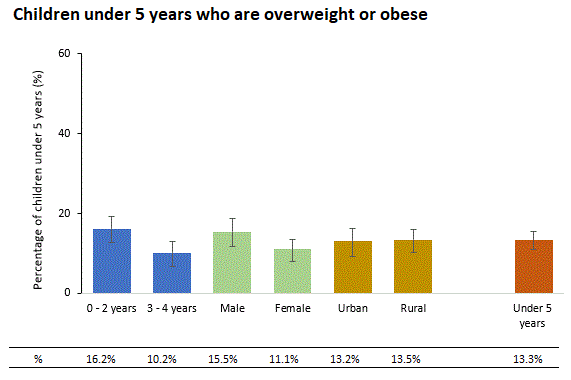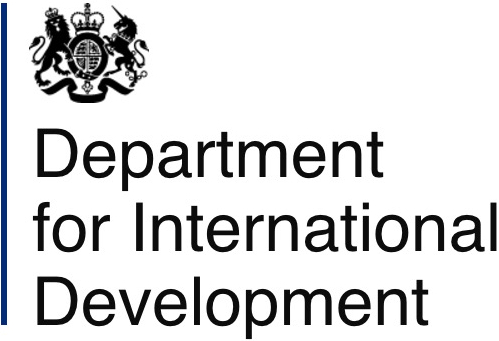Definition
Overnutrition occurs when there is an excessive intake of dietary energy. It manifests in two main forms: overweight and obesity.
- Children under five years old are defined as overweight when their weight-for-height is greater than two standard deviations above the WHO reference cut-off point.
- They are defined as obese when their weight-for-height is more than three standard deviations above the WHO Child Growth Standards.
- Among children older than five years, body mass index (BMI) is used to classify children into four categories: normal weight, thin, severely thin, overweight, and obese.
Data

Notes
Source
National Department of Health, Statistics South Africa, South African Medical Research Council and ICF (2017) South African Demographic & Health Survey 2016: Key Indicators. Pretoria and Rockville, Maryland: NDOH, Stats SA, SAMRC & ICF. Analysis by Winnie Sambu.
What do the numbers tell us?
Overweight and obesity in early childhood increases the risk for adult obesity, as well as associated conditions like high cholesterol, diabetes and high blood pressure.1 All of these are conditions with rising prevalence in South Africa.
Consumption of high-calorie diets, including those that are rich in salt, sugar and fats, is a main cause of overweight and obesity among children and adults. This is in turn influenced by other factors such as household poverty coupled with the high cost of healthy foods. Another contributing factor is an increasingly sedentary lifestyle. Maternal feeding practices and cultural beliefs about ideal child weight have also been linked to overnutrition. In addition, the consumption of infant formula milk has been associated with childhood obesity because protein and energy intake are higher among infants who are formula-fed.2 Therefore, exclusive breastfeeding for the first six months of a baby’s life is important as it protects against overweight and obesity in childhood, in addition to numerous other positive effects.3
Approximately 13% of South Africa’s children under five years are overweight. Overnutrition rates are higher among young boys than girls (15% vs 11%). There are no significant differences in overnutrition rates across urban and rural areas. Compared to estimates from the 2008 National Income Dynamics Study,4 overweight rates have remained fairly stable at 13%.
Overweight and obesity rates are significantly higher among older children. Data from the most recent wave of NIDS (2017) show 16% of children aged 5 – 9 and 22% of those aged 10 – 14 are classified as overweight or obese. Overall, 18% of children aged 15 – 17 years were found to be overweight or obese. The rate was significantly higher for girls (22%) than boys (15%), and for children living in urban areas (20%) compared to rural areas (16%).
1 Koplan JP, Liverman CT & Kraak VI (2005) Preventing childhood obesity: Health in the balance: Executive summary. Journal of the American Dietetic Association, 105(1): 131-138.
Lloyd LJ, Langley-Evans SC & McMullen S (2012) Childhood obesity and risk of the adult metabolic syndrome: A systematic review. International Journal of Obesity, 36(1): 1-11.
2 Horta BL & Victora CG (2013) Long-term health effects of breastfeeding: a systematic review. Lijec Vjesn, 129(8-9): 293-8;
See also WHO (2014) Exclusive breastfeeding to reduce the risk of childhood overweight and obesity. Available at: https://www.who.int/elena/titles/bbc/breastfeeding_childhood_obesity/en/.
3 Horta BL, Victora CG & World Health Organization (2013) Short-term effects of breastfeeding: a systematic review of the benefits of breastfeeding and pneumonia mortality. Geneva: World Health Organisation.
4 Southern Africa Labour and Development Research Unit (2018) National Income Dynamics Study (NIDS) Wave 1, 2008 [dataset]. Version 7.0.0. Pretoria: SA Presidency [funding agency]. Cape Town: Southern Africa Labour and Development Research Unit [implementer]. Cape Town: DataFirst [distributor].
Consumption of high-calorie diets, including those that are rich in salt, sugar and fats, is a main cause of overweight and obesity among children and adults. This is in turn influenced by other factors such as household poverty coupled with the high cost of healthy foods. Another contributing factor is an increasingly sedentary lifestyle. Maternal feeding practices and cultural beliefs about ideal child weight have also been linked to overnutrition. In addition, the consumption of infant formula milk has been associated with childhood obesity because protein and energy intake are higher among infants who are formula-fed.2 Therefore, exclusive breastfeeding for the first six months of a baby’s life is important as it protects against overweight and obesity in childhood, in addition to numerous other positive effects.3
Approximately 13% of South Africa’s children under five years are overweight. Overnutrition rates are higher among young boys than girls (15% vs 11%). There are no significant differences in overnutrition rates across urban and rural areas. Compared to estimates from the 2008 National Income Dynamics Study,4 overweight rates have remained fairly stable at 13%.
Overweight and obesity rates are significantly higher among older children. Data from the most recent wave of NIDS (2017) show 16% of children aged 5 – 9 and 22% of those aged 10 – 14 are classified as overweight or obese. Overall, 18% of children aged 15 – 17 years were found to be overweight or obese. The rate was significantly higher for girls (22%) than boys (15%), and for children living in urban areas (20%) compared to rural areas (16%).
1 Koplan JP, Liverman CT & Kraak VI (2005) Preventing childhood obesity: Health in the balance: Executive summary. Journal of the American Dietetic Association, 105(1): 131-138.
Lloyd LJ, Langley-Evans SC & McMullen S (2012) Childhood obesity and risk of the adult metabolic syndrome: A systematic review. International Journal of Obesity, 36(1): 1-11.
2 Horta BL & Victora CG (2013) Long-term health effects of breastfeeding: a systematic review. Lijec Vjesn, 129(8-9): 293-8;
See also WHO (2014) Exclusive breastfeeding to reduce the risk of childhood overweight and obesity. Available at: https://www.who.int/elena/titles/bbc/breastfeeding_childhood_obesity/en/.
3 Horta BL, Victora CG & World Health Organization (2013) Short-term effects of breastfeeding: a systematic review of the benefits of breastfeeding and pneumonia mortality. Geneva: World Health Organisation.
4 Southern Africa Labour and Development Research Unit (2018) National Income Dynamics Study (NIDS) Wave 1, 2008 [dataset]. Version 7.0.0. Pretoria: SA Presidency [funding agency]. Cape Town: Southern Africa Labour and Development Research Unit [implementer]. Cape Town: DataFirst [distributor].






 The SAECR 2024 tracks trends on the status of children under 6.
The SAECR 2024 tracks trends on the status of children under 6. 








